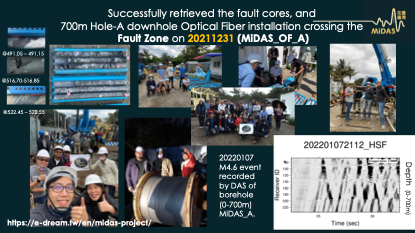Probing Fault Zone Dynamics and Near-Fault Ground Motion Using Downhole Crossing Fault Optical Fiber
Video not found
Please check back later. Videos are usually posted within 24 hours.
Kuo Fong Ma
Academia Sinica

- Date & Time
- Location
- Moffett Yosemite Room and Online via Microsoft Teams
- Host
- Walter Mooney
- Summary
The opportunity to observe fault zone behavior at depth with high spatial resolution is rare, and identifying the fault zone itself poses a significant challenge. However, the MiDAS (Milun-fault Drilling and All-inclusive Sensing) project has successfully addressed this challenge. We successfully retrieved the fault core associated with Milun fault zone, which could be also seen in geophysical logs with low velocity and resistivity. Through employing Optical Fiber Sensing techniques in the borehole after drilling, we are able to map and analyze the fault behavior. The Milun fault is known for frequent slip events and has generated several large earthquakes, such as the Mw6.4 Hualien earthquakes in February 2018, and M7.1 November 1951. Between 2021 and 2022, the project drilled and cored the fault, deploying a 3D multi-cross-fault fiber array. This array consisted of a down-hole loop at a depth of 700m (Hole-A) crossing the fault, a surface array crossing the fault rupture zone using commercial fiber, and another downhole loop of 500m fiber (Hole-B) at the Footwall site. The combination of high-resolution data from distributed acoustic sensing (DAS) and the retrieved core and geophysical logs enables detailed characterization of the fault structure. Within the Milun fault zone, a 20m thick fault core with grey and black gouge was discovered from the cores. This fault gouge exhibits a distinct seismic feature, characterized by its consistent amplification of strain records from DAS with an amplification ratio of approximately 2.5-3 for various types of events, when compared to channels at deeper depths consisting of consolidated rock material. Despite the narrowness of the fault gouge, its strong material contrast contributes to the observed amplification in strain. These findings shed light on the understanding of fault zone dynamics, particularly in terms of remote earthquake triggering and near-fault ground motions. Similar features were observed at the surface, with a wider surface rupture zone of approximately 200m evident in DAS data and supported by geophones crossing the surface rupture of the 2018 Hualien earthquake. Moving through the depth, the downhole optical fiber and cores reveal a high-resolution asymmetric feature of this active fault. Furthermore, our borehole DAS recordings from the M7.0 Chishang earthquake on September 18, 2022, indicate static-strain changes throughout the depth. These changes have the potential to assist in mapping a 3D strain-field associated with significant earthquakes. The direct probing of the fault zone through this emerging high-resolution technology is an exciting development and holds promise for gaining innovative insights into fault zone dynamics.
 Jump to Navigation
Jump to Navigation